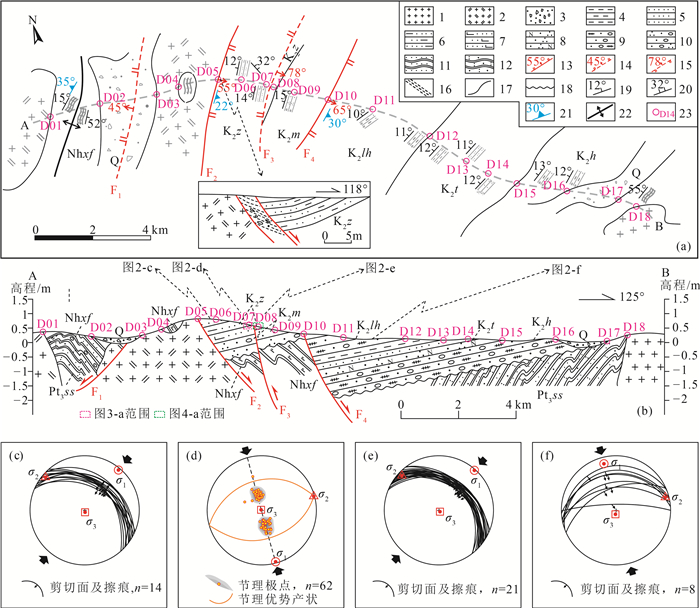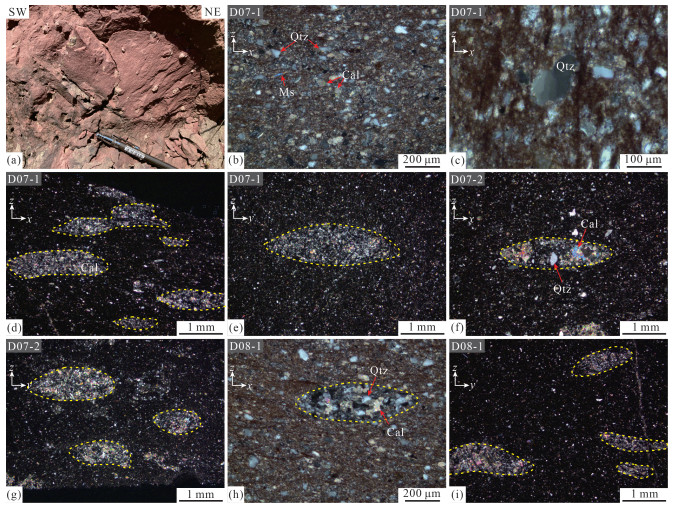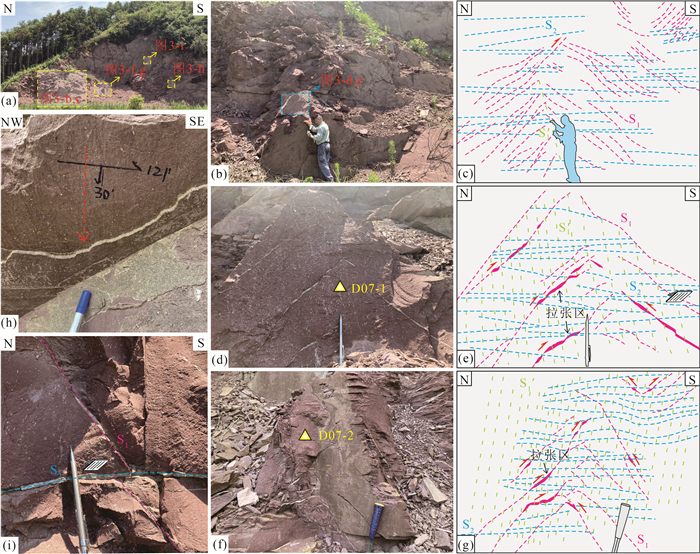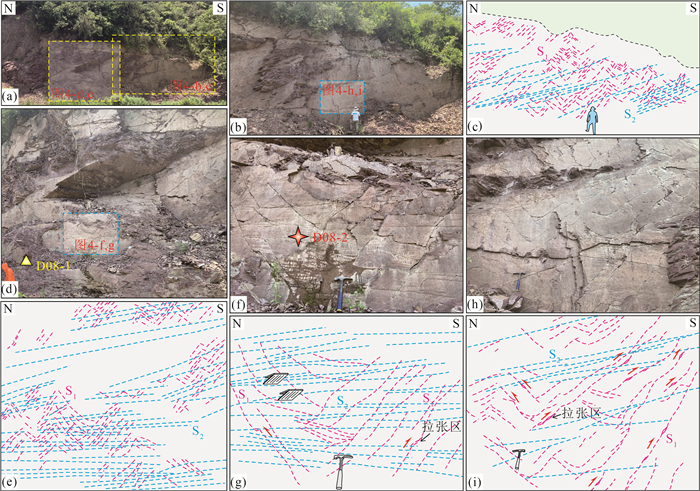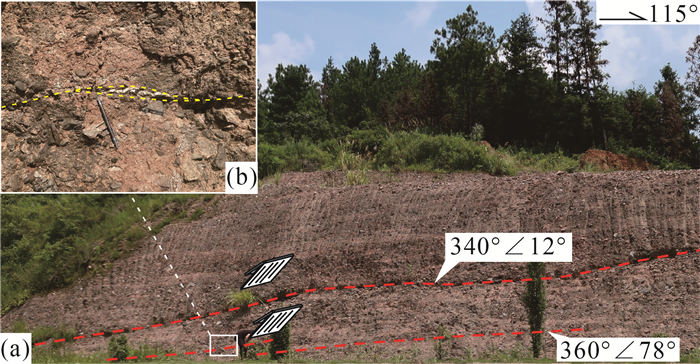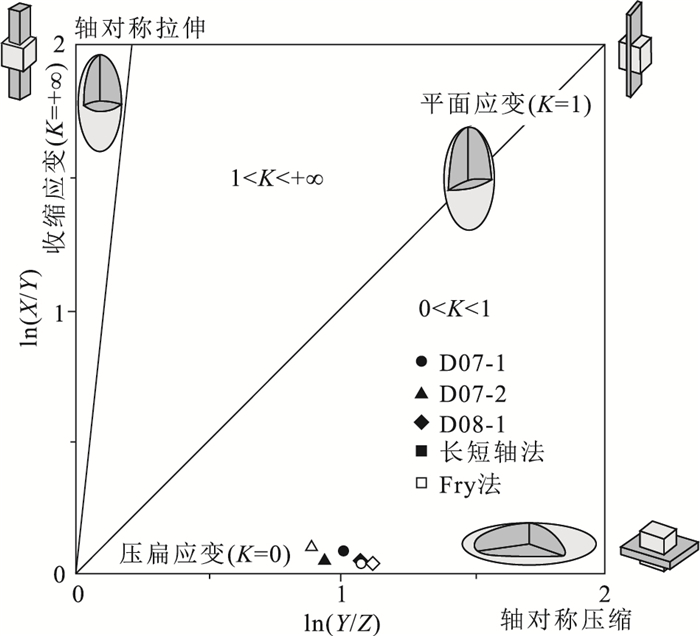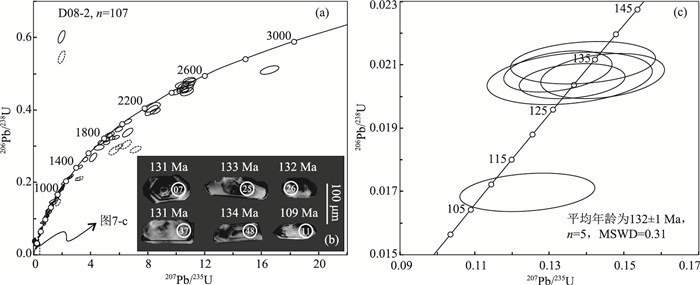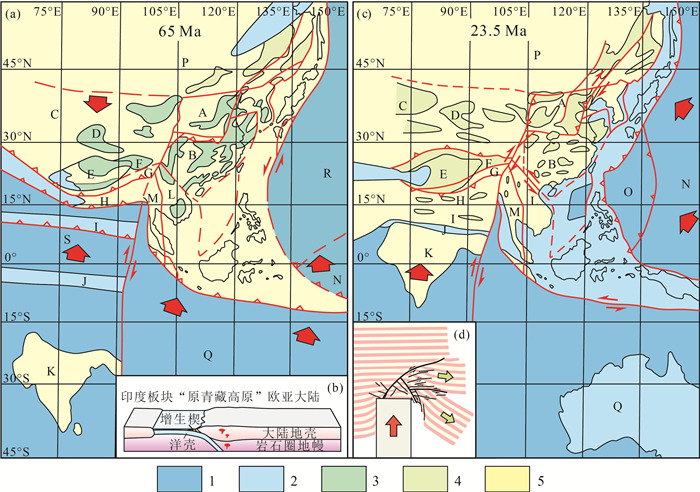Deformation characteristics of Cretaceous strata and its dynamic background, southwestern Fuzhou Basin, Jiangxi
-
摘要:
抚州盆地南西段潭丘—戴坊一带出露陆相红色碎屑沉积岩,锆石U-Pb测年限定该套地层的沉积下限为109 Ma,印证了前人将其划归为上白垩统的认识。野外构造观测和显微应变测量表明,上白垩统发育2期挤压构造变形:第一期NNW向挤压以NEE向共轭剪节理和压扁状钙质结核为主要识别特征,岩石应变类型主要为压扁型;第二期NE向挤压作用以发育NW向逆冲剪切破裂为识别标志,小规模切割错断第一期变形构造。结合中新生代中国东部构造演化历史,探讨并提出上述构造变形的动力学背景如下:第一期NNW向挤压可能与古近纪早期印度板块北向运移与欧亚大陆间的碰撞作用有关;第二期NE向挤压事件可能与赣江断裂带右行走滑派生的局部挤压应力场有关,其动力背景可能为古近纪中晚期印度板块对欧亚板块碰撞引发青藏高原物质东向挤出。
Abstract:The continental red clastic sedimentary rocks are exposed in the Tanqiu-Daifang area in the southwestern part of Fuzhou Basin.Zircon U-Pb dating sets the sedimentary lower limit of this formation at 109 Ma, confirming the previous understanding that it was classified as the Upper Cretaceous.Field observations show that there are two stages of compressional tectonic deformation developed in the Upper Cretaceous strata.The first stage of NNW-trending compression was mainly characterized by NEE-trending conjugate joints and flattened calcareous concretions.Systematic measurements of finite strain of calcareous concretions in the calcareous siltstone indicate the strain type was mainly flattening strain.The second stage of NE-trending compression was marked by the development of NW-trending thrusting fractures, which cut the first stage of deformations on a small scale.Combined with the tectonic evolution history of eastern China in the Mesozoic and Cenozoic, the dynamic backgrounds of these deformations are determined: the first stage NNW-trending compression may be related to the northward migration of Indian Plate and subsequent collision with the Eurasia Plate in the Early Paleogene; the second stage of NE-trending compression may be associated with the local compressive stress field derived from the dextral strike sliping of the Ganjiang fault zone, and its dynamic background may be the eastward escape of Tibetan Plateau caused by the collision between Indian and Eurasian plates during the middle to Late Paleogene.
-
陆内变形一般远离大陆边缘,受洋陆俯冲或陆陆碰撞的远程效应控制,其中洋壳俯冲能触发上覆板片宽度大于1300 km的陆内变形(Coney, 1977; Li et al., 2007),而陆陆碰撞形成的变形带宽度可达2000 km(Molnar et al., 1975; Yin, 2010)。陆内变形的研究对深入了解板块边缘大地构造过程具有重要的意义(Li et al., 2014a; 2020)。
华南大陆以规模宏大的中新生代陆内变形和火成岩省为典型特征(McKenzie, 1972; Molnar et al., 1975; Ren et al., 2002; Li et al., 2012),不仅是研究东亚大陆中新生代大地构造过程的关键区域,更是了解板块边缘俯冲或碰撞作用如何控制陆内变形的理想地区(李建华, 2013)。华南东部发育大量中、新生代盆地,因蕴含特殊的大地构造与区域成矿意义而受到广泛关注(余心起等, 2003; 2005;舒良树等, 2004; 张岳桥等, 2004; 江新胜等, 2006; Shu et al., 2007; 2009;Hu et al., 2008a)。前人对其构造变形序列及形成背景进行了有益探讨(张进等, 2010; Li et al., 2012; 2014b;张岳桥等, 2012; 柏道远等, 2013a, b; 2015;Xu et al., 2016)。然而,由于这些盆地所处大地构造位置和边界条件的差异,其构造变形与形成演化不尽相同,因此对不同盆地构造变形序列的厘定显得尤为重要。曾广乾等(2021a)通过对抚州盆地内不同产状与运动学性质的小型断裂、节理和褶皱的构造解析,建立了盆地中新生代构造变形序列,并探讨了构造演化与相山铀成矿的耦合关系,但对变形序次的厘定缺少直接的证据。本文通过对抚州盆地南西段潭丘—戴坊一带精细的路线填图和野外构造解析,结合定向构造标本的应变测量和碎屑锆石U-Pb测年,厘定了白垩系中2期构造变形,探讨其动力学背景,以期为中新生代区域构造演化提供基础地质资料。
1. 地质背景
研究区位于抚州盆地南西段,抚州盆地处于扬子地块与华夏地块的结合部位,赣杭断裂控制其北界(图 1-a)。抚州盆地系晚白垩世—古近纪断陷盆地,(残留)盆地呈NE—SW向展布,南西段较窄而北东段开阔,长约200 km,宽10~30 km,面积约3081 km2(陈留勤等, 2013)。盆地北西缘上白垩统与前白垩纪地层以遂川-德兴断裂(F4)接触,而南东缘二者以角度不整合接触(图 1-b),剖面上呈半地堑式或箕状。
![]() 图 1 研究区构造位置(a)、区域地质简图(b)和区域地层柱状图(c)(据江西省地质调查院, 2009修改)1—早白垩世花岗岩;2—中侏罗世二长花岗岩;3—志留纪晚期二长花岗岩;4—正断层;5—逆断层;6—性质不明断层;7—整合界线;8—角度不整合界线;9—岩层产状;10—浮土;11—泥岩;12—粉砂岩;13—泥质粉砂岩;14—钙质粉砂岩;15—石英砂岩;16—长石石英砂岩;17—含砾杂砂岩;18—含砾石英砂岩;19—碎斑熔岩;20—绢云千枚岩;21—变余粉砂岩;22—变余凝灰质砂岩;23—变余砂砾岩;24—大理岩;25—平行不整合;26—角度不整合;27—实测构造路线;F1—潭丘断裂;F2—长垄断裂;F3—东元断裂;F4—遂川-德兴断裂Figure 1. Location(a), regional geological map(b) and stratigraphic column(c)of the study area in the southwestern part of Fuzhou Basin
图 1 研究区构造位置(a)、区域地质简图(b)和区域地层柱状图(c)(据江西省地质调查院, 2009修改)1—早白垩世花岗岩;2—中侏罗世二长花岗岩;3—志留纪晚期二长花岗岩;4—正断层;5—逆断层;6—性质不明断层;7—整合界线;8—角度不整合界线;9—岩层产状;10—浮土;11—泥岩;12—粉砂岩;13—泥质粉砂岩;14—钙质粉砂岩;15—石英砂岩;16—长石石英砂岩;17—含砾杂砂岩;18—含砾石英砂岩;19—碎斑熔岩;20—绢云千枚岩;21—变余粉砂岩;22—变余凝灰质砂岩;23—变余砂砾岩;24—大理岩;25—平行不整合;26—角度不整合;27—实测构造路线;F1—潭丘断裂;F2—长垄断裂;F3—东元断裂;F4—遂川-德兴断裂Figure 1. Location(a), regional geological map(b) and stratigraphic column(c)of the study area in the southwestern part of Fuzhou Basin研究区出露的基底岩石由新元古代与南华纪浅变质砂泥质岩系组成,经历多期变质、变形作用。沉积盖层包括侏罗纪和早白垩世火山-碎屑岩。晚白垩世沉积呈角度不整合叠覆于前白垩纪地层之上,包括抚州盆地北西侧的茅店组(K2m)、周田组(K2z),为一套河流相—淡水湖相复成分泥砂砾岩建造,以及盆地内的河口组(K2h)、塘边组(K2t)、莲荷组(K2lh),为一套冲积相-河流相复成分砂砾岩建造,二者呈平行不整合接触(图 1-c)。古近系新余组(E1x)分布范围极小,零星出露于戴坊周缘,为一套淡水湖相复成分砂砾岩建造,岩层近水平,与下伏上白垩统呈低角度不整合接触。
志留纪、中侏罗世二长花岗岩和早白垩世花岗岩在研究区广泛出露,前二者分别为加里东运动和早燕山运动在本区的岩浆记录,而后者为早白垩世旋回火山喷发期后的次火山岩侵入,岩性主要为花岗斑岩和似斑状花岗岩(陈正乐等, 2013; 杨水源等, 2013)。
2. 白垩系构造变形特征
本次选取潭丘—戴坊一带开展精细的路线填图和构造解析,由北西向南东依次穿越了前寒武纪基底与晚白垩世盖层,共布置了18个观察点。在每个观察点上详细地收集了沉积构造、地层产状(S0)、千枚理、劈理、节理、褶皱、断层等构造数据。在综合分析以上数据并参照前人地质图的基础上,制作了路线地质图(图 2-a)和构造剖面(图 2-b)。研究显示,上白垩统主要遭受2期挤压作用(图 2),分别为第一期NNW向挤压和第二期NE向挤压。
![]() 图 2 研究区路线地质图(a)、剖面图(b)和构造要素投影(c~f)(地层代号同图 1)1—花岗岩;2—二长花岗岩;3—浮土;4—泥岩;5—粉砂岩;6—泥质粉砂岩;7—钙质粉砂岩;8—长石石英砂岩9—含砾杂砂岩;10—含砾石英砂岩;11—变余粉砂岩;12—变余凝灰质砂岩;13—正断层;14—推测正断层;15—推测逆断层;16—断层劈理;17—整合界线;18—角度不整合界线;19—岩层产状;20—剪切破裂产状;21—劈理产状;22—背斜;23—观察点Figure 2. Geological map(a), cross section(b) and lower hemisphere equal-area projections of the structural elements(c~f)in the study area
图 2 研究区路线地质图(a)、剖面图(b)和构造要素投影(c~f)(地层代号同图 1)1—花岗岩;2—二长花岗岩;3—浮土;4—泥岩;5—粉砂岩;6—泥质粉砂岩;7—钙质粉砂岩;8—长石石英砂岩9—含砾杂砂岩;10—含砾石英砂岩;11—变余粉砂岩;12—变余凝灰质砂岩;13—正断层;14—推测正断层;15—推测逆断层;16—断层劈理;17—整合界线;18—角度不整合界线;19—岩层产状;20—剪切破裂产状;21—劈理产状;22—背斜;23—观察点Figure 2. Geological map(a), cross section(b) and lower hemisphere equal-area projections of the structural elements(c~f)in the study area2.1 第一期NNW向挤压
第一期挤压作用(D1)以发育共轭剪节理和压扁状钙质结核为识别特征。这2类变形构造集中出现在断裂F3附近(图 2-a、b),D07和D08点处见宽约50 m的良好露头,向外侧岩石变形强度明显减弱,其中钙质结核呈近等轴状(图版Ⅰ-a)。岩石应变集中于如此狭窄地带,可能与断裂F3活动造成局部应力集中有关。通过详细的观测与统计,共获得62组节理的产状数据(图 2-d)。共轭节理由2组NEE向节理组成,出露在周田组紫红色钙质粉砂岩中,发育较稳定,节理面上擦痕不甚发育,沿节理面不具明显位移,统计获得节理优势产状分别为345°∠32°和164°∠34°。2组节理共轭关系清晰,体现在:二者之间的锐夹角约66°;2组节理相互交切(图 3-b、c,图 4-b~e);2组节理均表现为逆冲式剪切性质,在节理的弯转部位形成拉张空间,且部分充填方解石,2组节理运动学指向的组合样式指示锐夹角方向的挤入和钝夹角方向的挤出(图 3-d~g,图 4-f~i)。压扁状钙质结核呈白色或浅灰白色,其最大扁平面平行共轭节理的钝角平分面(图 3-b~g),显示其与共轭节理形成于统一的挤压构造应力场。
共轭节理作为地壳浅层次变形中最普遍的一种脆性构造,可以很好地反映某一地区的构造应力场特征(Becker et al., 1996; Arlegui et al., 2001; Eyal et al., 2001)。共轭节理与构造主应力方位存在一定的几何关系:一对共轭剪节理的交线平行于中间主应力方向,其锐角等分线平行于最大主应力方向,而钝角等分线平行最小主应力方向(唐永等, 2015; 曾广乾等, 2021b)。经统计并求取研究区共轭节理的优势产状,获得3个主应力轴产状分别为:σ1165°∠1°,σ274°∠1°,σ3300°∠88°,反映研究区经历了一期NNW向挤压事件(图 2-b)。
此外,在观测点D11处上白垩统莲荷组复成分砂砾岩中发育一组NEE—EW向小断裂(图 5),断面产状为340°~360°∠12°~78°,断裂破碎带内充填石英细脉,根据摩擦镜面擦痕与阶步及脉体的宽窄变化,判断该组断裂具逆冲兼右行走滑特征。通过构造应力场计算,获得该组断裂形成时的主应力:σ1方位为345°∠8°,σ2方位为75°∠4°,σ3方位为195°∠88°,亦指示了一期NNW向挤压作用的存在(图 2-f)。
2.2 第二期NE向挤压
第二期挤压作用(D2)以逆冲剪切破裂为识别标志。该组剪切破裂广泛出现在茅店组和周田组中,在观测路线D05~D09点间均有发育,走向NW向,呈中低角度,倾向NE,其中D05、D06点间破裂面的优势产状为35°∠32°(图 2-c),D07~D09点间破裂面的优势产状为37°∠31°(图 2-e),表明剪切破裂产状较稳定。单条破裂出露长度数十厘米至数米不等,破裂宽度介于0.1~1 cm之间,部分充填方解石。破裂面较平直光滑,其上发育擦痕与正阶步(图 3-h),指示该组破裂的运动学性质以逆冲剪切为主,部分破裂具少许走滑分量。通过构造应力场计算,获得该组剪切破裂形成时的主应力:σ1方位为42°∠1°,σ2方位为313°∠4°,σ3方位为154°∠87°,反映一期NE向挤压事件(图 2-c、e)。该组剪切破裂切割错断早期共轭节理和压扁状钙质结核,错距0~20 cm不等(图 3-i),反映前者形成时间晚于后两者。
综合上述变形序列与构造应力场分析结果可知,在抚州盆地南西段白垩系中记录有2期方向不同的挤压作用,即第一期为NNW向挤压作用,第二期为NE向挤压作用。
3. 岩石有限应变测量
岩石有限应变测量是现代构造地质研究中重要的组成部分,主要通过对变形岩石中应变标志体的测量来确定岩石有限应变的大小和方向,进而确立岩石的应变状态,查明岩石的变形机制(Bailey et al., 2003; Liang et al., 2015a,b)。岩石有限应变测量的方法较多,主要有几何作图法、莫尔圆制图法、长短轴法、Rf/φ法、θ曲线法、Elliott法、心对心法、Fry法、双晶应变分析法等(Ramsay, 1980; 郑亚东等, 1985)。本文选用长短轴法和Fry法进行有限应变测量。
首先,根据共轭节理的交线和钝角平分面,确定2个主应变面切制显微薄片(垂直交线为XZ面,平行交线且垂直钝角平分面作为YZ面),然后在2个显微薄片上分别进行应变测量。应变测量过程中,选择合适的应变标志体极关键。考虑到钙质结核粒径较大、变形易测量而含量较低的特点,本次研究中长短轴法选择钙质结核作为应变标志体,而Fry法则以岩石中普遍分布的石英颗粒为测量对象。
本次选取D07和D08点处变形强烈的3件钙质粉砂岩样品进行统计分析,采样位置见图 3和图 4。钙质粉砂岩主要由石英和方解石组成,另含少量白云母、褐铁矿等(图版Ⅰ-b),石英发育扇形波状消光现象(图版Ⅰ-c)。钙质结核主要由方解石和少量石英构成,在XZ面和YZ面上均呈椭圆状产出(图版Ⅰ-d~i)。显微镜下选择合适的区域采集显微照片,长短轴法和Fry法测量统计分别借助Straindesk 1.1和CorelDRAW软件实现,每一个定向样品的2个应变面(XZ和YZ面)分别测量标志体40~60个,具体操作流程见韩阳光等(2015)。计算得出变形钙质粉砂岩有限应变测量数据(X/Y值通过换算可得),长短轴法和Fry法测量结果较集中,较一致,接近真实应变水平(表 1)。
表 1 变形钙质粉砂岩有限应变测量数据Table 1. Finite-strain measurement data of deformed calcareous siltstone样品号 长短轴法 Fry法 X/Z Y/Z X/Y K X/Z Y/Z X/Y K D07-1 2.99 2.75 1.09 0.09 3.05 2.93 1.04 0.04 D07-2 2.79 2.64 1.05 0.05 2.97 2.69 1.10 0.10 D08-1 3.06 2.92 1.05 0.05 3.18 3.06 1.04 0.04 有限应变类型的判别常用的方法是Flinn判别图解(李建波等, 2015)。根据Flinn参数K值(K=ln(X/Y)/ln(Y/Z))范围,将Flinn图解分成几个不同的变形类型:①轴对称压缩(K=0~0.15);②一般压缩(K=0.15~0.67);③平面应变(K=0.67~1.5);④一般拉伸(K=1.5~6.67);⑤轴对称拉伸(K=6.67~+∞)(郑亚东等, 1985; 梁琛岳等, 2015)。对研究区变形岩石有限应变测量结果进行对数Flinn图解判别(图 6),3个样品投在压扁应变区域,K值在0.04~0.10之间,显示应变类型主要为压扁型,揭示其与共轭剪节理的形成均受制于纯剪切应变机制。曾广乾等(2021a)在抚州盆地上白垩统中识别出NEE向直立水平褶皱,指示其变形机制主要为纵弯褶皱作用下的岩层整体水平收缩(曾广乾等, 2019),亦为纯剪变形产物。
4. 碎屑锆石U-Pb测年
D07和D08点处第一期挤压变形切割改造了紫红色钙质粉砂岩,因此,该套钙质粉砂岩的沉积时代可限制这一期构造变形的时间下限。江西省地质调查院(2009)将这套钙质粉砂岩划归为上白垩统周田组,但由于其出露于主控盆断裂F4的北西侧,岩石质地相对坚硬(固结程度高),且无化石资料,故该套地层的沉积时代尚存疑问。为限定该套钙质粉砂岩的沉积时代,本次选择变形较强的1件钙质粉砂岩样品(D08-2,采样位置见图 4)进行锆石U-Pb测年。
锆石分选、制靶及阴极发光(CL)照相均在河北廊坊诚信地质服务公司完成。锆石U-Pb定年分析在武汉上谱分析科技有限责任公司利用LA-ICP-MS分析完成,具体操作流程见相关文献(Ludwig, 2003; Hu et al., 2008b; Liu et al., 2010)。钙质粉砂岩中锆石多为自形—半自形晶,呈浑圆状—短柱状,指示较差的磨圆度和较近的源区。在CL图像上,多数锆石发育振荡生长环带(图 7-b),具有相对高的Th/U值(0.14~2.18),显示岩浆锆石的特点;少量锆石呈无结构或补丁状特点,且具有相对低的Th/U值(<0.1),暗示它们为变质成因。随机选取107个锆石颗粒,选择无环带重叠、裂隙和包裹体的区域进行U-Pb定年分析,对其中99个不谐和度小于10%的分析点进行年龄统计(图 7-a;表 2)。这些分析点的年龄值分布在109~3062 Ma之间,集中在380~452 Ma、830~1139 Ma、1765~2083 Ma和2214~2561 Ma四个年龄峰值区。5颗约130 Ma锆石的存在,反映该套地层沉积时早白垩世花岗岩已抬升剥露至地表。最小的单颗粒碎屑锆石年龄为109±2 Ma(图 7-c),该锆石粒度较大,振荡生长环带清晰,Th/U=0.76,为典型的岩浆成因锆石(吴元保等, 2004)。研究表明,沉积岩中碎屑锆石的最小年龄能限定沉积地层时代的下限(Dickinson et al., 2009; Cawood et al., 2012; 曾先进等, 2021)。本次分析的钙质粉砂岩样品最年轻碎屑锆石的谐和年龄为109±2 Ma,表明其沉积时代不早于109 Ma,与前人认为的该套岩石为晚白垩世沉积的推断较一致。岩石因固结程度较高而明显区别于其他上白垩统红层,可能与岩石的粒度较细和钙质成分较高有关。
表 2 钙质粉砂岩中碎屑锆石LA-ICP-MS U-Th-Pb同位素分析结果Table 2. LA-ICP-MS U-Th-Pb isotopic dating results for the detrital zircons from calcareous siltstone样号 元素含量/10-6 Th/U 同位素比值 同位素年龄/Ma 不谐和度 Th U 207Pb/206Pb 1σ 207Pb/235U 1σ 206Pb/238U 1σ 207Pb/206Pb 1σ 207Pb/235U 1σ 206Pb/238Pb 1σ D08-2-01 303 392 0.77 0.0501 0.0020 0.2208 0.0091 0.0320 0.0004 198 99 203 8 203 2 1% D08-2-02 101 106 0.95 0.0542 0.0025 0.4736 0.0216 0.0642 0.0009 389 73 394 15 401 5 2% D08-2-03 114 346 0.33 0.1148 0.0021 5.0720 0.0989 0.3202 0.0029 1876 33 1831 17 1791 14 3% D08-2-04 130 160 0.81 0.1645 0.0027 10.3888 0.1814 0.4573 0.0034 2503 28 2470 16 2428 15 2% D08-2-05 162 490 0.33 0.0566 0.0014 0.5393 0.0137 0.0690 0.0006 476 56 438 9 430 3 2% D08-2-06 389 390 1.00 0.0677 0.0013 1.2830 0.0256 0.1375 0.0010 857 41 838 11 830 6 1% D08-2-07 284 408 0.69 0.0484 0.0022 0.1360 0.0059 0.0205 0.0002 117 106 130 5 131 1 1% D08-2-08 95.7 159 0.60 0.1288 0.0021 6.5857 0.1101 0.3701 0.0028 2083 28 2057 15 2030 13 2% D08-2-09 94.8 106 0.90 0.1540 0.0027 8.4756 0.1500 0.3986 0.0032 2391 30 2283 16 2163 15 6% D08-2-10 256 810 0.32 0.0540 0.0011 0.4873 0.0100 0.0652 0.0005 372 44 403 7 407 3 2% D08-2-11 159 208 0.76 0.0533 0.0032 0.1242 0.0075 0.0170 0.0002 343 131 119 7 109 2 10% D08-2-12 111 256 0.43 0.1229 0.0021 5.9388 0.1094 0.3491 0.0028 1999 32 1967 16 1930 13 2% D08-2-13 262 84.0 3.11 0.1653 0.0030 10.7464 0.1991 0.4701 0.0040 2511 30 2501 17 2484 17 1% D08-2-14 61.2 113 0.54 0.0631 0.0024 0.9392 0.0351 0.1088 0.0018 722 81 672 18 666 10 2% D08-2-15 96.9 63.4 1.53 0.0642 0.0027 1.0992 0.0433 0.1255 0.0015 750 90 753 21 762 9 2% D08-2-16 75.9 214 0.36 0.0568 0.0018 0.6055 0.0192 0.0771 0.0007 483 70 481 12 479 4 1% D08-2-17 121 239 0.51 0.1147 0.0020 5.2532 0.0891 0.3309 0.0027 1876 31 1861 15 1843 13 1% D08-2-18 110 175 0.63 0.0578 0.0021 0.5775 0.0210 0.0725 0.0008 520 86 463 14 451 5 3% D08-2-19 247 275 0.90 0.0759 0.0016 1.8114 0.0385 0.1725 0.0016 1092 47 1050 14 1026 9 3% D08-2-20 62.0 290 0.21 0.0769 0.0015 1.8289 0.0350 0.1717 0.0013 1118 44 1056 13 1022 7 4% D08-2-21 198 379 0.52 0.0568 0.0015 0.4744 0.0119 0.0606 0.0005 483 59 394 8 379 3 4% D08-2-22 56.171.70.780.10910.00283.20650.08770.21180.002417854614592112391317%D08-2-23 103 78.3 1.32 0.0614 0.0025 0.7659 0.0317 0.0904 0.0010 654 89 577 18 558 6 4% D08-2-24 130 205 0.63 0.0710 0.0014 1.6273 0.0322 0.1657 0.0012 967 41 981 12 988 7 1% D08-2-25 158 357 0.44 0.0468 0.0022 0.1324 0.0059 0.0208 0.0003 39.0 107 126 5 133 2 5% D08-2-26 140 281 0.50 0.0509 0.0023 0.1444 0.0067 0.0206 0.0003 235 106 137 6 132 2 4% D08-2-27 127 294 0.43 0.1155 0.0021 5.3413 0.0990 0.3343 0.0026 1888 33 1875 16 1859 12 1% D08-2-28 189 211 0.90 0.0543 0.0019 0.5232 0.0178 0.0701 0.0008 383 76 427 12 437 5 3% D08-2-29 153 691 0.22 0.0562 0.0012 0.5511 0.0118 0.0710 0.0007 461 50 446 8 442 4 1% D08-2-30 113 125 0.90 0.0583 0.0028 0.5155 0.0238 0.0644 0.0008 539 106 422 16 402 5 5% D08-2-31 64.7 95.1 0.68 0.0511 0.0023 0.5013 0.0207 0.0717 0.0009 256 102 413 14 446 5 8% D08-2-32 393 373 1.06 0.0852 0.0015 2.5525 0.0486 0.2160 0.0020 1321 34 1287 14 1260 10 3% D08-2-33 130 218 0.60 0.0558 0.0016 0.5552 0.0156 0.0723 0.0008 443 67 448 10 450 5 1% D08-2-34 2997200.420.14370.00225.94980.10390.29900.003222722119691516861616%D08-2-35 231 346 0.67 0.0532 0.0014 0.5193 0.0137 0.0705 0.0005 345 59 425 9 439 3 4% D08-2-36 592 272 2.18 0.1582 0.0030 10.3064 0.1951 0.4707 0.0034 2436 33 2463 18 2486 15 1% D08-2-37 73.3 150 0.49 0.0477 0.0034 0.1355 0.0090 0.0206 0.0003 87.1 168 129 8 131 2 2% D08-2-38 12.6 16.3 0.77 0.1474 0.0047 8.2574 0.2401 0.4097 0.0055 2317 54 2260 26 2214 25 3% D08-2-39 321 765 0.42 0.0533 0.0015 0.2442 0.0063 0.0332 0.0002 343 63 222 5 211 1 6% D08-2-40 113 268 0.42 0.0573 0.0016 0.5762 0.0159 0.0727 0.0006 506 61 462 10 452 4 3% D08-2-41 59.3 73.7 0.81 0.0698 0.0025 1.0996 0.0370 0.1149 0.0012 922 69 753 18 701 7 8% D08-2-42 208 269 0.77 0.1079 0.0019 4.6706 0.0809 0.3123 0.0023 1765 33 1762 15 1752 11 1% D08-2-43 116 1286 0.09 0.0747 0.0012 1.7554 0.0277 0.1694 0.0011 1061 33 1029 10 1009 6 2% D08-2-44 115 125 0.92 0.0755 0.0018 1.5428 0.0364 0.1477 0.0012 1081 48 948 15 888 6 7% D08-2-45 47.5 653 0.07 0.0548 0.0011 0.5011 0.0099 0.0660 0.0004 406 44 412 7 412 3 1% D08-2-46 4027030.570.08200.00161.68930.05990.14530.00351256391005238752014%D08-2-47 376 414 0.91 0.0962 0.0017 3.2652 0.0603 0.2448 0.0019 1551 34 1473 14 1412 10 5% D08-2-48 109 253 0.43 0.0481 0.0028 0.1390 0.0079 0.0211 0.0003 106 133 132 7 134 2 2% D08-2-49 128 65.6 1.95 0.0548 0.0023 0.7123 0.0300 0.0941 0.0011 467 94 546 18 580 6 7% D08-2-50 64.0 678 0.09 0.0550 0.0012 0.5126 0.0112 0.0674 0.0005 409 47 420 8 420 3 1% D08-2-51 164 389 0.42 0.0572 0.0014 0.5650 0.0143 0.0714 0.0006 498 56 455 9 445 3 3% D08-2-52 307 456 0.67 0.0777 0.0013 1.9249 0.0320 0.1792 0.0012 1139 33 1090 11 1063 7 3% D08-2-53 679 590 1.15 0.0556 0.0013 0.4669 0.0110 0.0607 0.0005 435 52 389 8 380 3 3% D08-2-54 391 748 0.52 0.0644 0.0013 0.9341 0.0185 0.1049 0.0007 754 42 670 10 643 4 5% D08-2-55 28.3 35.6 0.80 0.1104 0.0035 4.5378 0.1454 0.2979 0.0030 1805 58 1738 27 1681 15 4% D08-2-56 316 333 0.95 0.0773 0.0014 1.8831 0.0351 0.1762 0.0012 1128 32 1075 12 1046 7 3% D08-2-57 75.8 158 0.48 0.1141 0.0019 5.2174 0.0892 0.3309 0.0026 1866 30 1855 15 1843 13 1% D08-2-58 173 1437 0.12 0.0712 0.0010 1.4146 0.0216 0.1437 0.0009 961 30 895 9 865 5 4% D08-2-59 101 155 0.65 0.0627 0.0019 1.0261 0.0296 0.1187 0.0010 698 63 717 15 723 6 1% D08-2-60 376 314 1.20 0.1647 0.0028 10.8623 0.1933 0.4770 0.0042 2506 28 2511 17 2514 18 1% D08-2-61 393 471 0.83 0.0553 0.0013 0.4898 0.0116 0.0641 0.0005 433 54 405 8 401 3 1% D08-2-62 161 369 0.44 0.1473 0.0024 8.2026 0.1873 0.4013 0.0061 2315 28 2254 21 2175 28 4% D08-2-63 260 507 0.51 0.1653 0.0022 10.4956 0.1419 0.4590 0.0026 2510 22 2480 13 2435 12 2% D08-2-64 2162290.940.06580.00290.30460.01330.03360.000412009727010213224%D08-2-65 54.5 139 0.39 0.2315 0.0036 16.4259 0.2763 0.5129 0.0047 3062 25 2902 16 2669 20 9% D08-2-66 283 734 0.39 0.0734 0.0013 1.6096 0.0275 0.1585 0.0011 1028 35 974 11 948 6 3% D08-2-67 80.4 41.6 1.93 0.0673 0.0034 1.1173 0.0526 0.1224 0.0018 856 104 762 25 744 10 3% D08-2-68 73.9 97.8 0.76 0.1704 0.0029 10.6748 0.1919 0.4529 0.0041 2561 29 2495 17 2408 18 4% D08-2-69 136 183 0.74 0.0572 0.0023 0.4197 0.0165 0.0536 0.0006 498 89 356 12 336 4 6% D08-2-70 86.3 98.5 0.88 0.0653 0.0026 0.9414 0.0378 0.1049 0.0016 787 90 674 20 643 9 5% D08-2-71 251 235 1.07 0.0587 0.0019 0.5037 0.0166 0.0619 0.0006 567 73 414 11 387 4 7% D08-2-72 110 313 0.35 0.0531 0.0020 0.3077 0.0110 0.0420 0.0004 345 81 272 9 265 3 3% D08-2-73 3542761.280.15150.00306.43580.15580.30620.004823633320372117222417%D08-2-74 78.8 186 0.42 0.0596 0.0020 0.5549 0.0183 0.0675 0.0006 591 69 448 12 421 4 7% D08-2-75 148 135 1.10 0.0747 0.0021 1.5969 0.0419 0.1549 0.0012 1061 53 969 16 928 7 5% D08-2-76 193 225 0.86 0.1680 0.0030 10.7175 0.1764 0.4608 0.0042 2538 31 2499 15 2443 19 3% D08-2-77 119 160 0.74 0.0561 0.0021 0.5428 0.0195 0.0702 0.0007 457 85 440 13 437 4 1% D08-2-78 107 876 0.12 0.0572 0.0014 0.4897 0.0103 0.0618 0.0004 498 56 405 7 387 3 5% D08-2-79 43.5 72.2 0.60 0.0696 0.0029 1.3348 0.0546 0.1385 0.0016 917 92 861 24 836 9 3% D08-2-80 45.0 484 0.09 0.1262 0.0027 5.6975 0.0978 0.3257 0.0021 2056 37 1931 15 1818 10 7% D08-2-81 126 351 0.36 0.1212 0.0024 5.4442 0.0896 0.3242 0.0021 1974 35 1892 14 1810 10 5% D08-2-82 2.94 132 0.02 0.0541 0.0026 0.3965 0.0181 0.0534 0.0006 376 109 339 13 335 4 2% D08-2-83 108 153 0.71 0.0979 0.0022 3.5972 0.0786 0.2653 0.0023 1584 43 1549 17 1517 12 3% D08-2-84 70.7 152 0.46 0.0655 0.0019 1.0162 0.0284 0.1126 0.0014 791 61 712 14 688 8 4% D08-2-85 1132140.530.10610.00223.08120.05970.21030.00151800391428151230815%D08-2-86 570 572 1.00 0.0552 0.0013 0.4927 0.0116 0.0646 0.0005 420 54 407 8 404 3 1% D08-2-87 59.9 705 0.09 0.0538 0.0012 0.4901 0.0104 0.0659 0.0004 361 44 405 7 412 3 2% D08-2-88 38.1 233 0.16 0.0561 0.0017 0.4995 0.0156 0.0645 0.0006 457 69 411 11 403 3 3% D08-2-89 252 211 1.20 0.0658 0.0021 0.7574 0.0224 0.0839 0.0007 1200 73 573 13 519 4 10% D08-2-90 46.9 245 0.19 0.0543 0.0016 0.5768 0.0170 0.0772 0.0007 383 64 462 11 479 4 4% D08-2-91 37.7 257 0.15 0.1110 0.0021 4.1525 0.1034 0.2712 0.0048 1817 35 1665 20 1547 24 8% D08-2-92 91.4 175 0.52 0.1627 0.0041 10.8369 0.1853 0.4817 0.0033 2484 43 2509 16 2535 14 2% D08-2-93 89.6 556 0.16 0.0688 0.0018 1.2542 0.0344 0.1320 0.0012 892 54 825 15 799 7 4% D08-2-94 193 148 1.30 0.1177 0.0022 5.0698 0.0960 0.3114 0.0021 1921 33 1831 16 1747 10 5% D08-2-95 52.5 143 0.37 0.1580 0.0025 9.8844 0.1511 0.4521 0.0031 2435 25 2424 14 2404 14 1% D08-2-96 289 517 0.56 0.0519 0.0014 0.2847 0.0075 0.0397 0.0003 280 63 254 6 251 2 2% D08-2-97 2124010.530.17430.00307.09600.15110.29280.003425992921241916561725%D08-2-98 130 82.8 1.57 0.0668 0.0027 1.3579 0.0496 0.1480 0.0015 831 88 871 21 890 9 3% D08-2-99 204 218 0.93 0.0730 0.0015 1.6584 0.0352 0.1640 0.0012 1013 43 993 13 979 7 2% D08-2-100 38.3 280 0.14 0.1606 0.0023 10.4048 0.1828 0.4667 0.0051 2462 24 2471 16 2469 22 1% D08-2-101 72.9 129 0.56 0.0575 0.0025 0.5394 0.0220 0.0682 0.0007 509 99 438 15 425 4 3% D08-2-102 133 224 0.60 0.0769 0.0017 2.0298 0.0484 0.1899 0.0020 1120 43 1126 16 1121 11 1% D08-2-103 186 285 0.65 0.0540 0.0019 0.3116 0.0104 0.0418 0.0004 372 78 275 8 264 2 5% D08-2-104 73.0 154 0.47 0.0818 0.0017 2.4010 0.0479 0.2119 0.0015 1240 41 1243 14 1239 8 1% D08-2-105 195 1353 0.14 0.1389 0.0021 6.5777 0.1416 0.3395 0.0047 2214 26 2056 19 1884 23 9% D08-2-106 447 723 0.62 0.0553 0.0012 0.5258 0.0119 0.0685 0.0006 433 48 429 8 427 3 1% D08-2-107 10636911.540.13870.00255.63680.15380.29010.004922132719222416422516%注:对年龄≥1000 Ma的样品,采用207Pb/206Pb表面年龄;对年龄<1000 Ma的样品,采用206Pb/238U表面年龄;不谐和度=2*(207Pb/235U-206Pb/238U)/(207Pb/235U+206Pb/238U)*100;带删除线的数据不谐和度>10%, 故未选入年龄统计 5. 构造变形的动力学背景
记录第一期挤压变形的紫红色钙质粉砂岩中最年轻碎屑锆石的谐和年龄为109±2 Ma,印证了前人将之划归为上白垩统周田组的认识,同时也表明第一期挤压变形发生在晚白垩世以来。晚白垩世期间华南为伸展构造体制,以发育大量断陷盆地为特征,盆地长轴和地层展布多呈NE—SW向(余心起等, 2003; 舒良树等, 2004; 徐先兵, 2011)。区域地质资料表明(图 1-c),周田组与上覆河口组之间为平行不整合接触,暗示二者之间存在一次块体隆升事件,可能与晚白垩世同构造伸展拆离导致地块的差异升降有关(曾广乾等, 2021a)。同时,笔者注意到,上白垩统与古近系之间为角度不整合接触,揭示古近纪早期存在一期区域挤压事件,且NNW向挤压作用形成的NNW向正断层控制了古近系新余组沉积(曾广乾等, 2021a),表明第一期挤压作用很可能与该期角度不整合事件对应。基于以上变形序列和区域构造演化背景,笔者对2期挤压作用的动力学背景进行了探讨。
华南中新生代构造演化受太平洋构造域和特提斯洋构造域的联合控制(Ren et al., 2002)。Koppers et al.(2001;2003)、Sun et al.(2007)通过对太平洋海山岛链的时空分布研究,揭示太平洋板块的漂移方向曾经发生多次转折,其中100~43 Ma太平洋板块NW—NNW向俯冲于欧亚板块之下。Yang(2013)提出,欧亚板块东侧的鄂霍茨克地块在89~77 Ma沿着东亚边界以NNW向漂移,并在东亚边缘形成与圣安德烈斯断裂体系类似的左旋大陆转换边界。考虑到太平洋板块和鄂霍茨克地块的俯冲方向与东亚边界夹角较小,且抚州盆地及其邻区上白垩统为伸展沉积,笔者认为,上述板块构造过程对中国东部产生的正向挤压作用应该较小。万天丰等(2002)、万天丰(2004)指出,从早白垩世中期开始至古近纪早期(四川期晚期,135~52 Ma),由于印度板块北侧的新特提斯洋壳向欧亚大陆之下的近正向俯冲,中国东部各地块持续向北运移达纬度十余度。至晚白垩世,因印度板块北侧洋壳向欧亚大陆进一步下插的难度增大,板块向北运移速度降至10 cm/a,由此发生印度板块与欧亚大陆之间的软碰撞(Klootwijk et al., 1992)。这一时期中国东部构造应力场的最大主压应力方向为近SN向,但因所处大地构造位置和边界条件的差异,不同块体内部所受挤压方向可能存在角度偏差。因此,笔者将抚州盆地南西段古近纪早期NNW向挤压事件的主要动力学背景归结为印度板块向北运移与欧亚大陆间的碰撞作用(图 8-a、b)。NNW向挤压事件终止了晚白垩世的地壳伸展过程,这期挤压事件在华南诸多晚白垩世盆地中存在记录。张族坤等(2019)通过对粤北南雄盆地沉积相和物源变化的研究,认为盆地形成和演化经历了由扩张到萎缩的过程,反映古新世中晚期(约60 Ma)华南东部经历了由伸展向挤压的构造体制转换。
![]() 图 8 四川期晚期(65 Ma)中国大陆及邻区构造古地理复原图(a)、印度板块北向俯冲模型(b)、华北期晚期(23.5 Ma)中国大陆及邻区构造古地理复原图(c)和青藏高原挤出模型(d)(图a、图c据万天丰, 2004; Sun et al., 2007;图d据Tapponnier et al., 1986)A—中朝板块;B—华南板块(包括扬子与华夏板块);C—哈萨克斯坦板块;D—准噶尔板块;E—塔里木地块;F—柴达木地块;G—昆仑地块;H—羌塘地块.;I—冈底斯地块;J—喜马拉雅地块;K—印度板块;L—思茅-印度支那板块;M—保山-中缅马苏地块;N—太平洋板块;O—菲律宾海板块;P—兴安岭-蒙古-天山褶皱带;Q—澳大利亚板块;R—伊佐奈歧板块;S—新特提斯洋板块;1—大洋;2—陆表海;3—陆相干旱盆地;4—陆相潮湿盆地;5—陆上低地、丘陵Figure 8. Paleo-tectonogeographic construction sketch of China continent and its adjacent areas in late stage of Sichuannian (65 Ma) (a), northward subduction model of Indian Plate (b), paleo-tectonogeographic construction sketch of China continent and its adjacent areas in late stage of North Sinian (23.5 Ma) (c) and extrusion model of Tibetan Plateau (d)
图 8 四川期晚期(65 Ma)中国大陆及邻区构造古地理复原图(a)、印度板块北向俯冲模型(b)、华北期晚期(23.5 Ma)中国大陆及邻区构造古地理复原图(c)和青藏高原挤出模型(d)(图a、图c据万天丰, 2004; Sun et al., 2007;图d据Tapponnier et al., 1986)A—中朝板块;B—华南板块(包括扬子与华夏板块);C—哈萨克斯坦板块;D—准噶尔板块;E—塔里木地块;F—柴达木地块;G—昆仑地块;H—羌塘地块.;I—冈底斯地块;J—喜马拉雅地块;K—印度板块;L—思茅-印度支那板块;M—保山-中缅马苏地块;N—太平洋板块;O—菲律宾海板块;P—兴安岭-蒙古-天山褶皱带;Q—澳大利亚板块;R—伊佐奈歧板块;S—新特提斯洋板块;1—大洋;2—陆表海;3—陆相干旱盆地;4—陆相潮湿盆地;5—陆上低地、丘陵Figure 8. Paleo-tectonogeographic construction sketch of China continent and its adjacent areas in late stage of Sichuannian (65 Ma) (a), northward subduction model of Indian Plate (b), paleo-tectonogeographic construction sketch of China continent and its adjacent areas in late stage of North Sinian (23.5 Ma) (c) and extrusion model of Tibetan Plateau (d)抚州盆地南西段上白垩统记录的晚期NE向挤压事件,在中国东部白垩纪盆地中普遍被识别,如渤海盆地(Allen et al., 1997)、胶莱盆地(Zhang et al., 2003; 申文杰等, 2020)、黄山盆地(Xu et al., 2016)、浙江西部白垩纪盆地(Li et al., 2014b)和沅麻盆地(张进等, 2010; Li et al., 2012; 2014a;张岳桥等, 2012; 柏道远等, 2015)。43 Ma左右,太平洋板块俯冲方向由NNW向转变为NW向(Koppers et al., 2001; 2003;Sun et al., 2007),与研究区晚期挤压应力方向呈大角度相交,暗示后者与太平洋板块俯冲作用无关。Molnar et al.(1975)、Yin(2010)、张岳桥等(2012)、Li et al.(2012;2014b)、Xu et al.(2016)认为,华南的这期NE向挤压与古近纪晚期(渐新世)印度-欧亚大陆的俯冲和碰撞有关。张进等(2010)、柏道远等(2015)则认为,该期挤压变形的形成背景为古近纪中期(中新世前后)印度-欧亚板块碰撞致使亚洲东部形成一系列右行走滑断裂并派生NE向挤压作用。万天丰等(2002)指出,印度板块于华北期(52~23.3 Ma)与欧亚板块发生硬碰撞,但关于放射虫的研究表明,二者之间新特提斯洋壳消失的真正时间在渐新世末期(Aitchison et al., 2001),由此青藏高原物质发生大规模的向东构造逃逸,形成对华南东部的强烈东向挤压。在此动力背景下,亚洲东部先存NNE向断裂普遍发生右行走滑,如日本海东西缘断裂(Jolivet et al., 1994)、辽河-伊通-依兰断裂(万天丰, 1993; 李宏伟等, 2001)、郯庐断裂(Gilder et al., 1999)、溆浦-靖州断裂、通道-安化断裂(柏道远等, 2014)等。同样受这一动力学体制影响,抚州盆地西侧的NNE向赣江断裂带(邓平等, 2003)亦发生强烈右旋剪切,进而派生NE向局部挤压应力场,可能是红盆晚期变形的动力来源(图 8-c、d)。古近纪中晚期NE向挤压应力场还导致江汉盆地、珠江三角洲盆地古近系发生强烈冲断、褶皱,并被新近系角度不整合覆盖(刘景彦等, 2009; Shinn et al., 2010)。
6. 结论
(1) 抚州盆地南西段上白垩统中记录了NNW向和NE向2期挤压构造事件。第一期NNW向挤压以NEE向共轭剪节理和压扁状钙质结核为主要识别特征,应变类型主要为压扁型。第二期NE向挤压作用以发育逆冲剪切破裂为识别标志,小规模切割错断第一期变形构造。
(2) 第一期NNW向挤压可能与古近纪早期印度板块N向运移与欧亚大陆间的碰撞作用有关。第二期NE向挤压事件可能与赣江断裂带右行走滑派生的局部挤压应力场有关,其动力背景可能为古近纪中晚期印度板块对欧亚板块碰撞引发青藏高原物质向东逃逸。
致谢: 武汉上谱分析科技有限责任公司在锆石U-Pb定年分析测试过程中给予帮助,审稿专家为本文质量的提升提出了建设性意见,在此一并表示感谢。 -
图 1 研究区构造位置(a)、区域地质简图(b)和区域地层柱状图(c)(据江西省地质调查院, 2009修改)
1—早白垩世花岗岩;2—中侏罗世二长花岗岩;3—志留纪晚期二长花岗岩;4—正断层;5—逆断层;6—性质不明断层;7—整合界线;8—角度不整合界线;9—岩层产状;10—浮土;11—泥岩;12—粉砂岩;13—泥质粉砂岩;14—钙质粉砂岩;15—石英砂岩;16—长石石英砂岩;17—含砾杂砂岩;18—含砾石英砂岩;19—碎斑熔岩;20—绢云千枚岩;21—变余粉砂岩;22—变余凝灰质砂岩;23—变余砂砾岩;24—大理岩;25—平行不整合;26—角度不整合;27—实测构造路线;F1—潭丘断裂;F2—长垄断裂;F3—东元断裂;F4—遂川-德兴断裂
Figure 1. Location(a), regional geological map(b) and stratigraphic column(c)of the study area in the southwestern part of Fuzhou Basin
图 2 研究区路线地质图(a)、剖面图(b)和构造要素投影(c~f)(地层代号同图 1)
1—花岗岩;2—二长花岗岩;3—浮土;4—泥岩;5—粉砂岩;6—泥质粉砂岩;7—钙质粉砂岩;8—长石石英砂岩9—含砾杂砂岩;10—含砾石英砂岩;11—变余粉砂岩;12—变余凝灰质砂岩;13—正断层;14—推测正断层;15—推测逆断层;16—断层劈理;17—整合界线;18—角度不整合界线;19—岩层产状;20—剪切破裂产状;21—劈理产状;22—背斜;23—观察点
Figure 2. Geological map(a), cross section(b) and lower hemisphere equal-area projections of the structural elements(c~f)in the study area
图 8 四川期晚期(65 Ma)中国大陆及邻区构造古地理复原图(a)、印度板块北向俯冲模型(b)、华北期晚期(23.5 Ma)中国大陆及邻区构造古地理复原图(c)和青藏高原挤出模型(d)(图a、图c据万天丰, 2004; Sun et al., 2007;图d据Tapponnier et al., 1986)
A—中朝板块;B—华南板块(包括扬子与华夏板块);C—哈萨克斯坦板块;D—准噶尔板块;E—塔里木地块;F—柴达木地块;G—昆仑地块;H—羌塘地块.;I—冈底斯地块;J—喜马拉雅地块;K—印度板块;L—思茅-印度支那板块;M—保山-中缅马苏地块;N—太平洋板块;O—菲律宾海板块;P—兴安岭-蒙古-天山褶皱带;Q—澳大利亚板块;R—伊佐奈歧板块;S—新特提斯洋板块;1—大洋;2—陆表海;3—陆相干旱盆地;4—陆相潮湿盆地;5—陆上低地、丘陵
Figure 8. Paleo-tectonogeographic construction sketch of China continent and its adjacent areas in late stage of Sichuannian (65 Ma) (a), northward subduction model of Indian Plate (b), paleo-tectonogeographic construction sketch of China continent and its adjacent areas in late stage of North Sinian (23.5 Ma) (c) and extrusion model of Tibetan Plateau (d)
表 1 变形钙质粉砂岩有限应变测量数据
Table 1 Finite-strain measurement data of deformed calcareous siltstone
样品号 长短轴法 Fry法 X/Z Y/Z X/Y K X/Z Y/Z X/Y K D07-1 2.99 2.75 1.09 0.09 3.05 2.93 1.04 0.04 D07-2 2.79 2.64 1.05 0.05 2.97 2.69 1.10 0.10 D08-1 3.06 2.92 1.05 0.05 3.18 3.06 1.04 0.04 表 2 钙质粉砂岩中碎屑锆石LA-ICP-MS U-Th-Pb同位素分析结果
Table 2 LA-ICP-MS U-Th-Pb isotopic dating results for the detrital zircons from calcareous siltstone
样号 元素含量/10-6 Th/U 同位素比值 同位素年龄/Ma 不谐和度 Th U 207Pb/206Pb 1σ 207Pb/235U 1σ 206Pb/238U 1σ 207Pb/206Pb 1σ 207Pb/235U 1σ 206Pb/238Pb 1σ D08-2-01 303 392 0.77 0.0501 0.0020 0.2208 0.0091 0.0320 0.0004 198 99 203 8 203 2 1% D08-2-02 101 106 0.95 0.0542 0.0025 0.4736 0.0216 0.0642 0.0009 389 73 394 15 401 5 2% D08-2-03 114 346 0.33 0.1148 0.0021 5.0720 0.0989 0.3202 0.0029 1876 33 1831 17 1791 14 3% D08-2-04 130 160 0.81 0.1645 0.0027 10.3888 0.1814 0.4573 0.0034 2503 28 2470 16 2428 15 2% D08-2-05 162 490 0.33 0.0566 0.0014 0.5393 0.0137 0.0690 0.0006 476 56 438 9 430 3 2% D08-2-06 389 390 1.00 0.0677 0.0013 1.2830 0.0256 0.1375 0.0010 857 41 838 11 830 6 1% D08-2-07 284 408 0.69 0.0484 0.0022 0.1360 0.0059 0.0205 0.0002 117 106 130 5 131 1 1% D08-2-08 95.7 159 0.60 0.1288 0.0021 6.5857 0.1101 0.3701 0.0028 2083 28 2057 15 2030 13 2% D08-2-09 94.8 106 0.90 0.1540 0.0027 8.4756 0.1500 0.3986 0.0032 2391 30 2283 16 2163 15 6% D08-2-10 256 810 0.32 0.0540 0.0011 0.4873 0.0100 0.0652 0.0005 372 44 403 7 407 3 2% D08-2-11 159 208 0.76 0.0533 0.0032 0.1242 0.0075 0.0170 0.0002 343 131 119 7 109 2 10% D08-2-12 111 256 0.43 0.1229 0.0021 5.9388 0.1094 0.3491 0.0028 1999 32 1967 16 1930 13 2% D08-2-13 262 84.0 3.11 0.1653 0.0030 10.7464 0.1991 0.4701 0.0040 2511 30 2501 17 2484 17 1% D08-2-14 61.2 113 0.54 0.0631 0.0024 0.9392 0.0351 0.1088 0.0018 722 81 672 18 666 10 2% D08-2-15 96.9 63.4 1.53 0.0642 0.0027 1.0992 0.0433 0.1255 0.0015 750 90 753 21 762 9 2% D08-2-16 75.9 214 0.36 0.0568 0.0018 0.6055 0.0192 0.0771 0.0007 483 70 481 12 479 4 1% D08-2-17 121 239 0.51 0.1147 0.0020 5.2532 0.0891 0.3309 0.0027 1876 31 1861 15 1843 13 1% D08-2-18 110 175 0.63 0.0578 0.0021 0.5775 0.0210 0.0725 0.0008 520 86 463 14 451 5 3% D08-2-19 247 275 0.90 0.0759 0.0016 1.8114 0.0385 0.1725 0.0016 1092 47 1050 14 1026 9 3% D08-2-20 62.0 290 0.21 0.0769 0.0015 1.8289 0.0350 0.1717 0.0013 1118 44 1056 13 1022 7 4% D08-2-21 198 379 0.52 0.0568 0.0015 0.4744 0.0119 0.0606 0.0005 483 59 394 8 379 3 4% D08-2-22 56.171.70.780.10910.00283.20650.08770.21180.002417854614592112391317%D08-2-23 103 78.3 1.32 0.0614 0.0025 0.7659 0.0317 0.0904 0.0010 654 89 577 18 558 6 4% D08-2-24 130 205 0.63 0.0710 0.0014 1.6273 0.0322 0.1657 0.0012 967 41 981 12 988 7 1% D08-2-25 158 357 0.44 0.0468 0.0022 0.1324 0.0059 0.0208 0.0003 39.0 107 126 5 133 2 5% D08-2-26 140 281 0.50 0.0509 0.0023 0.1444 0.0067 0.0206 0.0003 235 106 137 6 132 2 4% D08-2-27 127 294 0.43 0.1155 0.0021 5.3413 0.0990 0.3343 0.0026 1888 33 1875 16 1859 12 1% D08-2-28 189 211 0.90 0.0543 0.0019 0.5232 0.0178 0.0701 0.0008 383 76 427 12 437 5 3% D08-2-29 153 691 0.22 0.0562 0.0012 0.5511 0.0118 0.0710 0.0007 461 50 446 8 442 4 1% D08-2-30 113 125 0.90 0.0583 0.0028 0.5155 0.0238 0.0644 0.0008 539 106 422 16 402 5 5% D08-2-31 64.7 95.1 0.68 0.0511 0.0023 0.5013 0.0207 0.0717 0.0009 256 102 413 14 446 5 8% D08-2-32 393 373 1.06 0.0852 0.0015 2.5525 0.0486 0.2160 0.0020 1321 34 1287 14 1260 10 3% D08-2-33 130 218 0.60 0.0558 0.0016 0.5552 0.0156 0.0723 0.0008 443 67 448 10 450 5 1% D08-2-34 2997200.420.14370.00225.94980.10390.29900.003222722119691516861616%D08-2-35 231 346 0.67 0.0532 0.0014 0.5193 0.0137 0.0705 0.0005 345 59 425 9 439 3 4% D08-2-36 592 272 2.18 0.1582 0.0030 10.3064 0.1951 0.4707 0.0034 2436 33 2463 18 2486 15 1% D08-2-37 73.3 150 0.49 0.0477 0.0034 0.1355 0.0090 0.0206 0.0003 87.1 168 129 8 131 2 2% D08-2-38 12.6 16.3 0.77 0.1474 0.0047 8.2574 0.2401 0.4097 0.0055 2317 54 2260 26 2214 25 3% D08-2-39 321 765 0.42 0.0533 0.0015 0.2442 0.0063 0.0332 0.0002 343 63 222 5 211 1 6% D08-2-40 113 268 0.42 0.0573 0.0016 0.5762 0.0159 0.0727 0.0006 506 61 462 10 452 4 3% D08-2-41 59.3 73.7 0.81 0.0698 0.0025 1.0996 0.0370 0.1149 0.0012 922 69 753 18 701 7 8% D08-2-42 208 269 0.77 0.1079 0.0019 4.6706 0.0809 0.3123 0.0023 1765 33 1762 15 1752 11 1% D08-2-43 116 1286 0.09 0.0747 0.0012 1.7554 0.0277 0.1694 0.0011 1061 33 1029 10 1009 6 2% D08-2-44 115 125 0.92 0.0755 0.0018 1.5428 0.0364 0.1477 0.0012 1081 48 948 15 888 6 7% D08-2-45 47.5 653 0.07 0.0548 0.0011 0.5011 0.0099 0.0660 0.0004 406 44 412 7 412 3 1% D08-2-46 4027030.570.08200.00161.68930.05990.14530.00351256391005238752014%D08-2-47 376 414 0.91 0.0962 0.0017 3.2652 0.0603 0.2448 0.0019 1551 34 1473 14 1412 10 5% D08-2-48 109 253 0.43 0.0481 0.0028 0.1390 0.0079 0.0211 0.0003 106 133 132 7 134 2 2% D08-2-49 128 65.6 1.95 0.0548 0.0023 0.7123 0.0300 0.0941 0.0011 467 94 546 18 580 6 7% D08-2-50 64.0 678 0.09 0.0550 0.0012 0.5126 0.0112 0.0674 0.0005 409 47 420 8 420 3 1% D08-2-51 164 389 0.42 0.0572 0.0014 0.5650 0.0143 0.0714 0.0006 498 56 455 9 445 3 3% D08-2-52 307 456 0.67 0.0777 0.0013 1.9249 0.0320 0.1792 0.0012 1139 33 1090 11 1063 7 3% D08-2-53 679 590 1.15 0.0556 0.0013 0.4669 0.0110 0.0607 0.0005 435 52 389 8 380 3 3% D08-2-54 391 748 0.52 0.0644 0.0013 0.9341 0.0185 0.1049 0.0007 754 42 670 10 643 4 5% D08-2-55 28.3 35.6 0.80 0.1104 0.0035 4.5378 0.1454 0.2979 0.0030 1805 58 1738 27 1681 15 4% D08-2-56 316 333 0.95 0.0773 0.0014 1.8831 0.0351 0.1762 0.0012 1128 32 1075 12 1046 7 3% D08-2-57 75.8 158 0.48 0.1141 0.0019 5.2174 0.0892 0.3309 0.0026 1866 30 1855 15 1843 13 1% D08-2-58 173 1437 0.12 0.0712 0.0010 1.4146 0.0216 0.1437 0.0009 961 30 895 9 865 5 4% D08-2-59 101 155 0.65 0.0627 0.0019 1.0261 0.0296 0.1187 0.0010 698 63 717 15 723 6 1% D08-2-60 376 314 1.20 0.1647 0.0028 10.8623 0.1933 0.4770 0.0042 2506 28 2511 17 2514 18 1% D08-2-61 393 471 0.83 0.0553 0.0013 0.4898 0.0116 0.0641 0.0005 433 54 405 8 401 3 1% D08-2-62 161 369 0.44 0.1473 0.0024 8.2026 0.1873 0.4013 0.0061 2315 28 2254 21 2175 28 4% D08-2-63 260 507 0.51 0.1653 0.0022 10.4956 0.1419 0.4590 0.0026 2510 22 2480 13 2435 12 2% D08-2-64 2162290.940.06580.00290.30460.01330.03360.000412009727010213224%D08-2-65 54.5 139 0.39 0.2315 0.0036 16.4259 0.2763 0.5129 0.0047 3062 25 2902 16 2669 20 9% D08-2-66 283 734 0.39 0.0734 0.0013 1.6096 0.0275 0.1585 0.0011 1028 35 974 11 948 6 3% D08-2-67 80.4 41.6 1.93 0.0673 0.0034 1.1173 0.0526 0.1224 0.0018 856 104 762 25 744 10 3% D08-2-68 73.9 97.8 0.76 0.1704 0.0029 10.6748 0.1919 0.4529 0.0041 2561 29 2495 17 2408 18 4% D08-2-69 136 183 0.74 0.0572 0.0023 0.4197 0.0165 0.0536 0.0006 498 89 356 12 336 4 6% D08-2-70 86.3 98.5 0.88 0.0653 0.0026 0.9414 0.0378 0.1049 0.0016 787 90 674 20 643 9 5% D08-2-71 251 235 1.07 0.0587 0.0019 0.5037 0.0166 0.0619 0.0006 567 73 414 11 387 4 7% D08-2-72 110 313 0.35 0.0531 0.0020 0.3077 0.0110 0.0420 0.0004 345 81 272 9 265 3 3% D08-2-73 3542761.280.15150.00306.43580.15580.30620.004823633320372117222417%D08-2-74 78.8 186 0.42 0.0596 0.0020 0.5549 0.0183 0.0675 0.0006 591 69 448 12 421 4 7% D08-2-75 148 135 1.10 0.0747 0.0021 1.5969 0.0419 0.1549 0.0012 1061 53 969 16 928 7 5% D08-2-76 193 225 0.86 0.1680 0.0030 10.7175 0.1764 0.4608 0.0042 2538 31 2499 15 2443 19 3% D08-2-77 119 160 0.74 0.0561 0.0021 0.5428 0.0195 0.0702 0.0007 457 85 440 13 437 4 1% D08-2-78 107 876 0.12 0.0572 0.0014 0.4897 0.0103 0.0618 0.0004 498 56 405 7 387 3 5% D08-2-79 43.5 72.2 0.60 0.0696 0.0029 1.3348 0.0546 0.1385 0.0016 917 92 861 24 836 9 3% D08-2-80 45.0 484 0.09 0.1262 0.0027 5.6975 0.0978 0.3257 0.0021 2056 37 1931 15 1818 10 7% D08-2-81 126 351 0.36 0.1212 0.0024 5.4442 0.0896 0.3242 0.0021 1974 35 1892 14 1810 10 5% D08-2-82 2.94 132 0.02 0.0541 0.0026 0.3965 0.0181 0.0534 0.0006 376 109 339 13 335 4 2% D08-2-83 108 153 0.71 0.0979 0.0022 3.5972 0.0786 0.2653 0.0023 1584 43 1549 17 1517 12 3% D08-2-84 70.7 152 0.46 0.0655 0.0019 1.0162 0.0284 0.1126 0.0014 791 61 712 14 688 8 4% D08-2-85 1132140.530.10610.00223.08120.05970.21030.00151800391428151230815%D08-2-86 570 572 1.00 0.0552 0.0013 0.4927 0.0116 0.0646 0.0005 420 54 407 8 404 3 1% D08-2-87 59.9 705 0.09 0.0538 0.0012 0.4901 0.0104 0.0659 0.0004 361 44 405 7 412 3 2% D08-2-88 38.1 233 0.16 0.0561 0.0017 0.4995 0.0156 0.0645 0.0006 457 69 411 11 403 3 3% D08-2-89 252 211 1.20 0.0658 0.0021 0.7574 0.0224 0.0839 0.0007 1200 73 573 13 519 4 10% D08-2-90 46.9 245 0.19 0.0543 0.0016 0.5768 0.0170 0.0772 0.0007 383 64 462 11 479 4 4% D08-2-91 37.7 257 0.15 0.1110 0.0021 4.1525 0.1034 0.2712 0.0048 1817 35 1665 20 1547 24 8% D08-2-92 91.4 175 0.52 0.1627 0.0041 10.8369 0.1853 0.4817 0.0033 2484 43 2509 16 2535 14 2% D08-2-93 89.6 556 0.16 0.0688 0.0018 1.2542 0.0344 0.1320 0.0012 892 54 825 15 799 7 4% D08-2-94 193 148 1.30 0.1177 0.0022 5.0698 0.0960 0.3114 0.0021 1921 33 1831 16 1747 10 5% D08-2-95 52.5 143 0.37 0.1580 0.0025 9.8844 0.1511 0.4521 0.0031 2435 25 2424 14 2404 14 1% D08-2-96 289 517 0.56 0.0519 0.0014 0.2847 0.0075 0.0397 0.0003 280 63 254 6 251 2 2% D08-2-97 2124010.530.17430.00307.09600.15110.29280.003425992921241916561725%D08-2-98 130 82.8 1.57 0.0668 0.0027 1.3579 0.0496 0.1480 0.0015 831 88 871 21 890 9 3% D08-2-99 204 218 0.93 0.0730 0.0015 1.6584 0.0352 0.1640 0.0012 1013 43 993 13 979 7 2% D08-2-100 38.3 280 0.14 0.1606 0.0023 10.4048 0.1828 0.4667 0.0051 2462 24 2471 16 2469 22 1% D08-2-101 72.9 129 0.56 0.0575 0.0025 0.5394 0.0220 0.0682 0.0007 509 99 438 15 425 4 3% D08-2-102 133 224 0.60 0.0769 0.0017 2.0298 0.0484 0.1899 0.0020 1120 43 1126 16 1121 11 1% D08-2-103 186 285 0.65 0.0540 0.0019 0.3116 0.0104 0.0418 0.0004 372 78 275 8 264 2 5% D08-2-104 73.0 154 0.47 0.0818 0.0017 2.4010 0.0479 0.2119 0.0015 1240 41 1243 14 1239 8 1% D08-2-105 195 1353 0.14 0.1389 0.0021 6.5777 0.1416 0.3395 0.0047 2214 26 2056 19 1884 23 9% D08-2-106 447 723 0.62 0.0553 0.0012 0.5258 0.0119 0.0685 0.0006 433 48 429 8 427 3 1% D08-2-107 10636911.540.13870.00255.63680.15380.29010.004922132719222416422516%注:对年龄≥1000 Ma的样品,采用207Pb/206Pb表面年龄;对年龄<1000 Ma的样品,采用206Pb/238U表面年龄;不谐和度=2*(207Pb/235U-206Pb/238U)/(207Pb/235U+206Pb/238U)*100;带删除线的数据不谐和度>10%, 故未选入年龄统计 -
Aitchison J C, Davis A M. When did the India-Asia collision really happen? [J]. Gondwana Research, 2001, 4(4): 560-561. doi: 10.1016/S1342-937X(05)70363-4
Allen M B, MacDonald D I M, Xun Z, et al. Early Cenozoic two-phase extension and late Cenozoic thermal subsidence and inversion of the Bohai Basin, northern China[J]. Marine and Petroleum Geology, 1997, 14(7): 951-972.
Arlegui L, Simon J L. Geometry and distribution of regional joint sets in a non-homogeneous stress field: Case study in the Ebro basin(Spain)[J]. Journal of Structural Geology, 2001, 23(2): 297-313.
Bailey C M, Eyster E L. General shear deformation in the Pinaleno Mountains metamorphic core complex, Arizona[J]. Journal of Structural Geology, 2003, 25(11): 1883-1892. doi: 10.1016/S0191-8141(03)00044-0
Becker A, Gross M R. Mechanism for joint saturation in mechanically layeredrocks: An example from southern Israel[J]. Tectonophysics, 1996, 257: 223-237. doi: 10.1016/0040-1951(95)00142-5
Cawood P, Hawkesworth C J, Dhuime B. Detrital zircon record and tectonic setting[J]. Geology, 2012, 40(10): 875-878. doi: 10.1130/G32945.1
Coney P J, Reynolds S J. CordilleranBenioff zones[J]. Nature, 1977, 270: 403-406. doi: 10.1038/270403a0
Dickinson W R, Gehrels G E. Use of U-Pb ages of detrital zircons to infer maximum depositional ages of strata: A test against a Colorado Plateau Mesozoic database[J]. Earth and Planetary Science Letters, 2009, 288(1/2): 115-125.
Eyal Y, Gross M R, Engelder T, et al. Joint development during fluctuation of the regional stress field in southern Israel[J]. Journal of Structural Geology, 2001, 23(2): 279-296.
Gilder S A, Leloup P H, Courtillot V, et al. Tectonic evolution of the Tancheng-Lujiang(Tan-Lu)fault via Middle Triassic to Early Cenozoic paleomagnetic data[J]. Journal of Geophysical Research, 1999, 104(B7): 15365-15390. doi: 10.1029/1999JB900123
Hu R Z, Bi X W, Zhou M F, et al. Uraniummetallogenesis in South China and its relationship to crustal extension during the Cretaceous to Tertiary[J]. Economic Geology, 2008a, 103(3): 583-598. doi: 10.2113/gsecongeo.103.3.583
Hu Z C, Gao S, Liu Y S, et al. Signal enhancement in laser ablation ICP-MS by addition of nitrogen in thecentral channel gas[J]. Journal of Analytical Atomic Spectrometry, 2008b, 23: 1093-1101. doi: 10.1039/b804760j
Jolivet L, Tamaki K, Fournier M. Japan Sea, opening history and mechanism: A synthesis[J]. Journal of Geophysical Research, 1994, 99(B11): 22237-22259. doi: 10.1029/93JB03463
Klootwijk C T, Gee J S, Peirce J W, et al. An early India-Asia contact: Paleomagnetic constraints from Ninetyeast Ridge, ODP Leg 121[J]. Geology, 1992, 20(5): 395-398. doi: 10.1130/0091-7613(1992)020<0395:AEIACP>2.3.CO;2
Koppers A A P, Morgan J P, Morgan J W, et al. Testing the fixed hotspot hypothesis using 40Ar/39Ar age progressions along seamount trails[J]. Earth and Planetary Science Letters, 2001, 185(3/4): 237-252.
Koppers A A P, Staudigel H, Duncan R A. High-resolution 40Ar/39Ar dating of the oldest oceanic basement basalts in the western Pacific basin[J]. Geochemistry Geophysics Geosystems, 2003, 4(11): 8914.
Li Z X, Li X H. Formation of the 1300 km-wide intracontinental orogen and postorogenic magmatic province in Mesozoic South China: A flat-slab subduction model[J]. Geology, 2007, 35(2): 179-182. doi: 10.1130/G23193A.1
Li J H, Zhang Y Q, Dong S W, et al. Late Mesozoic-Early Cenozoic deformation history of theYuanma Basin, central South China[J]. Tectonophysics, 2012, 570/571: 163-183. doi: 10.1016/j.tecto.2012.08.012
Li J H, Zhang Y Q, Dong S W, et al. Cretaceous tectonic evolution of south China: A preliminary synthesis[J]. Earth-Science Reviews, 2014a, 134: 98-136. doi: 10.1016/j.earscirev.2014.03.008
Li J H, Ma Z L, Zhang Y Q, et al. Tectonic evolution of Cretaceous extensional basins in Zhejiang Province, eastern South China: Structural andgeochronological constraints[J]. International Geology Review, 2014b, 56(13): 1602-1629. doi: 10.1080/00206814.2014.951978
Li J H, Cawood P A, Ratschbacher L, et al. Building Southeast China in the late Mesozoic: Insights from alternating episodes of shortening and extension along the Lianhuashan fault zone[J]. Earth-Science Reviews, 2020, 201: 103056. doi: 10.1016/j.earscirev.2019.103056
Liang C Y, Liu Y J, Neubauer F, et al. Structural characteristics and LA-ICP-MS U-Pb zircon geochronology of the deformed granitic rocks from the Mesozoic Xingcheng-Taili ductile shear zone in the North China Craton[J]. Tectonophysics, 2015a, 650: 80-103. doi: 10.1016/j.tecto.2014.05.010
Liang C Y, Liu Y J, Neubauer F, et al. Structures, kinematic analysis, rheological parameters and temperature-pressure estimate of the Mesozoic Xingcheng-Taili ductile shear zone in the North China Craton[J]. Journal of Structural Geology, 2015b, 78: 27-51. doi: 10.1016/j.jsg.2015.06.007
Liu Y S, Gao S, Hu Z C, et al. Continental and oceanic crust recycling-induced melt-peridotite interactions in the Trans-North China Orogen: U-Pb dating, Hf isotopes and trace elements in zircons of mantle xenoliths[J]. Journal of Petrology, 2010, 51(1/2): 537-571.
Ludwig K R. User's Manual forIsoplot 3.0: A geochronological toolkit for Microsoft Excel[M]. Berkeley Geochronology Center, Special Publication, 2003, 4(1): 1-71.
McKenzie D. Active tectonics of the Mediterraneanregion[J]. Geophysical Journal of the Royal Astronomical Society, 1972, 30: 109-185. doi: 10.1111/j.1365-246X.1972.tb02351.x
Molnar P, Tapponnier P. Cenozoic tectonics of Asia: effects of a continental collision[J]. Science, 1975, 189(4201): 419-426. doi: 10.1126/science.189.4201.419
Ramsay J G. Shear zone geometry: A review[J]. Journal of Structural Geology, 1980, 2(1/2): 83-99.
Ren J Y, Tamaki K, Li S T, et al. Late Mesozoic and Cenozoic rifting and its dynamic setting in Eastern China and adjacentareas[J]. Tectonophysics, 2002, 344: 175-205. doi: 10.1016/S0040-1951(01)00271-2
Shinn Y J, Chough S K, Hwang I G. Structural development and tectonic evolution ofGunsan Basin(Cretaceous-Tertiary)in the central Yellow Sea[J]. Marine and Petroleum Geology, 2010, 27(2): 500-514. doi: 10.1016/j.marpetgeo.2009.11.001
Shu L S, Zhou X M, Deng P, et al. Mesozoic tectonic evolution of the Southeast China Block: New insights from basinanalysis[J]. Journal of Asian Earth Sciences, 2009, 34(3): 376-391. doi: 10.1016/j.jseaes.2008.06.004
Shu L S, Zhou X M, Deng P, et al. Mesozoic-Cenozoic basin features and evolution of Southeast China[J]. Acta Geologica Sinica, 2007, 81(4): 573-586. doi: 10.1111/j.1755-6724.2007.tb00981.x
Sun W D, Ding X, Hu Y H, et al. The golden transformation of the Cretaceous plate subduction in the westPacific[J]. Earth and Planetary Science Letters, 2007, 262(34): 533-542.
Tapponnier P, Peltzer G, Armijo R. On the mechanics of the collision between India and Asia[J]. Geological Society of London Special Publications, 1986, 19(1): 113-157. doi: 10.1144/GSL.SP.1986.019.01.07
Xu X B, Tang S, Lin S F. Paleostress inversion of fault-slip data from the Jurassic to Cretaceous Huangshan Basin and implications for the tectonic evolution of southeastern China[J]. Journal of Geodynamics, 2016, 98: 31-52. doi: 10.1016/j.jog.2016.03.013
Yang Y T. An unrecognized major collision of theOkhotomorsk Block with East Asia during the Late Cretaceous, constraints on the plate reorganization of the Northwest Pacific[J]. Earth-Science Reviews, 2013, 126: 96-115. doi: 10.1016/j.earscirev.2013.07.010
Yin A. Cenozoic tectonic evolution of Asia: A preliminarysynthesis[J]. Tectonophysics, 2010, 488(14): 293-325.
Zhang Y Q, Dong S W, Shi W. Cretaceous deformation history of the middle Tan-Lu fault zone in Shandong Province, eastern China[J]. Tectonophysics, 2003, 363(3/4): 243-258.
柏道远, 钟响, 贾朋远, 等. 雪峰造山带靖州盆地断裂构造及其形成背景探讨[J]. 大地构造与成矿学, 2013a, 37(2): 173-183. https://www.cnki.com.cn/Article/CJFDTOTAL-DGYK201302001.htm 柏道远, 钟响, 贾朋远, 等. 雪峰造山带南段靖州盆地成因性质及形成背景[J]. 中国地质, 2013b, 40(4): 1079-1091. https://www.cnki.com.cn/Article/CJFDTOTAL-DIZI201304008.htm 柏道远, 熊雄, 杨俊, 等. 雪峰造山带中段地质构造特征[J]. 中国地质, 2014, 41(2): 399-418. https://www.cnki.com.cn/Article/CJFDTOTAL-DIZI201402008.htm 柏道远, 姜文, 钟响, 等. 湘西沅麻盆地中新生代构造变形特征及区域地质背景[J]. 中国地质, 2015, 42(6): 1851-1875. https://www.cnki.com.cn/Article/CJFDTOTAL-DIZI201506014.htm 陈留勤, 郭福生, 梁伟, 等. 江西抚崇盆地上白垩统河口组砾石统计特征及其地质意义[J]. 现代地质, 2013, 27(3): 74-82. https://www.cnki.com.cn/Article/CJFDTOTAL-XDDZ201303007.htm 陈正乐, 王永, 周永贵, 等. 江西相山火山-侵入杂岩体锆石SHRIMP定年及其地质意义[J]. 中国地质, 2013, 40(1): 217-231. https://www.cnki.com.cn/Article/CJFDTOTAL-DIZI201301017.htm 邓平, 舒良树, 杨明桂, 等. 赣江断裂带地质特征及其动力学演化[J]. 地质论评, 2003, 49(2): 113-122. https://www.cnki.com.cn/Article/CJFDTOTAL-DZLP200302000.htm 韩阳光, 颜丹平, 李政林. 在CorelDRAW平台上进行Fry法有限应变测量的新技术[J]. 现代地质, 2015, 29(3): 494-500. https://www.cnki.com.cn/Article/CJFDTOTAL-XDDZ201503002.htm 江西省地质调查研究院. 江西省1: 25万抚州市幅建造构造图[R]. 2009. 江新胜, 潘忠习, 徐金沙, 等. 江西信江盆地晚白垩世风成沙丘的发现及其古风向[J]. 地质通报, 2006, 25(7): 833-838. http://dzhtb.cgs.cn/cn/article/id/200607150 李宏伟, 许坤. 郯庐断裂走滑活动与辽河盆地构造古地理格局[J]. 地学前缘, 2001, 8(4): 467-470. https://www.cnki.com.cn/Article/CJFDTOTAL-DXQY200104043.htm 李建波, 郭磊, 欧阳志侠, 等. 辽南变质核杂岩韧性拆离带的变形特征、应变与运动学涡度分析[J]. 北京大学学报(自然科学版), 2015, 51(6): 1078-1090. https://www.cnki.com.cn/Article/CJFDTOTAL-BJDZ201506013.htm 李建华. 华南中生代大地构造过程—源于北部大巴山和中部沅麻盆地、衡山的构造变形及年代学约束[D]. 中国地质科学院博士学位论文, 2013: 1-205. 梁琛岳, 刘永江, 孟婧瑶, 等. 舒兰韧性剪切带应变分析及石英动态重结晶颗粒分形特征与流变参数估算[J]. 地球科学, 2015, 40(1): 115-129. https://www.cnki.com.cn/Article/CJFDTOTAL-DQKX201501008.htm 刘景彦, 林畅松, 卢林, 等. 江汉盆地白垩-新近系主要不整合面剥蚀量分布及其构造意义[J]. 地质科技情报, 2009, 28(1): 1-8. https://www.cnki.com.cn/Article/CJFDTOTAL-DZKQ200901002.htm 申文杰, 刘少峰, 张博, 等. 胶莱盆地白垩纪构造演化[J]. 大地构造与成矿学, 2020, 44(3): 325-339. https://www.cnki.com.cn/Article/CJFDTOTAL-DGYK202003001.htm 舒良树, 周新民, 邓平, 等. 中国东南部中、新生代盆地特征与构造演化[J]. 地质通报, 2004, 23(910): 876-884. http://dzhtb.cgs.cn/cn/article/id/200409158 唐永, 刘怀庆, 黎清华, 等. 广西灵山断裂带构造应力场地质分析及活动性预测[J]. 大地构造与成矿学, 2015, 39(1): 62-75. https://www.cnki.com.cn/Article/CJFDTOTAL-DGYK201501007.htm 万天丰. 中国东部中、新生代板内变形构造应力场及其应用[M]. 北京: 地质出版社, 1993: 1-103. 万天丰, 朱鸿. 中国大陆及邻区中生代-新生代大地构造与环境变迁[J]. 现代地质, 2002, 16(2): 107-120. https://www.cnki.com.cn/Article/CJFDTOTAL-XDDZ200202000.htm 万天丰. 中国大地构造学纲要[M]. 北京: 地质出版社, 2004: 152-179. 吴元保, 郑永飞. 锆石成因矿物学研究及其对U-Pb年龄解释的制约[J]. 科学通报, 2004, 49(16): 1589-1604. https://www.cnki.com.cn/Article/CJFDTOTAL-KXTB200416001.htm 徐先兵. 武夷山地区显生宙构造变形与年代学研究[D]. 南京大学博士学位论文, 2011: 1-136. 杨水源, 蒋少涌, 赵葵东, 等. 江西相山铀矿田如意亭剖面火山岩的年代学格架及其地质意义[J]. 岩石学报, 2013, 29(12): 4362-4372. https://www.cnki.com.cn/Article/CJFDTOTAL-YSXB201312021.htm 余心起, 舒良树, 邓平, 等. 中国东南部侏罗纪-第三纪陆相地层沉积特征[J]. 地层学杂志, 2003, 27(3): 254-263. https://www.cnki.com.cn/Article/CJFDTOTAL-DCXZ200303017.htm 余心起, 舒良树, 颜铁增, 等. 赣杭构造带红层盆地原型及其沉积作用[J]. 沉积学报, 2005, 23(1): 12-20. https://www.cnki.com.cn/Article/CJFDTOTAL-CJXB200501001.htm 曾广乾, 梁恩云, 熊苗, 等. 湘南江永地区多期褶皱的变形特征及叠加关系[J]. 地质科技情报, 2019, 38(4): 153-165. https://www.cnki.com.cn/Article/CJFDTOTAL-DZKQ201904016.htm 曾广乾, 陈柏林, 申景辉, 等. 抚州盆地晚中生代—新生代构造变形特征、形成背景及地质意义[J]. 大地构造与成矿学, 2021a, 45(6): 1094-1110. https://www.cnki.com.cn/Article/CJFDTOTAL-DGYK202106002.htm 曾广乾, 梁恩云, 刘庚寅, 等. 桂北丹池成矿带南段五圩矿田构造变形、控矿特征和找矿预测[J]. 地质论评, 2021b, 67(6): 1727-1748. https://www.cnki.com.cn/Article/CJFDTOTAL-DZLP202106015.htm 曾先进, 王明, 范建军, 等. 拉萨-羌塘板块碰撞——来自西藏阿索晚白垩世红层的约束[J]. 地质通报, 2021, 40(9): 1428-1442. http://dzhtb.cgs.cn/cn/article/id/20210904 张进, 马宗晋, 杨健, 等. 雪峰山西麓中生代盆地属性及构造意义[J]. 地质学报, 2010, 84(5): 631-650. https://www.cnki.com.cn/Article/CJFDTOTAL-DZXE201005005.htm 张岳桥, 董树文, 李建华, 等. 华南中生代大地构造研究新进展[J]. 地球学报, 2012, 33(3): 257-279. https://www.cnki.com.cn/Article/CJFDTOTAL-DQXB201203001.htm 张岳桥, 赵越, 董树文, 等. 中国东部及邻区早白垩世裂陷盆地构造演化阶段[J]. 地学前缘, 2004, 11(3): 123-133. https://www.cnki.com.cn/Article/CJFDTOTAL-DXQY200403017.htm 张族坤, 徐亚军, 刘强, 等. 华南东部白垩纪晚期—古近纪构造转换的沉积记录——以粤北南雄盆地为例[J]. 大地构造与成矿学, 2019, 43(3): 575-589. https://www.cnki.com.cn/Article/CJFDTOTAL-DGYK201903014.htm 郑亚东, 常志忠. 岩石有限应变测量及韧性剪切带[M]. 北京: 地质出版社, 1985: 1-194. -
期刊类型引用(1)
1. 陈志友,曾广乾,柏道远,姚泽钰,王灵珏,文春华,陈旭,王勇,李彬,黄乐清,陈剑锋,梁恩云,许若潮,马慧英,向轲. 湘南大义山地区中—新生代变形序列及其动力学背景. 现代地质. 2024(04): 1092-1108 .  百度学术
百度学术
其他类型引用(1)



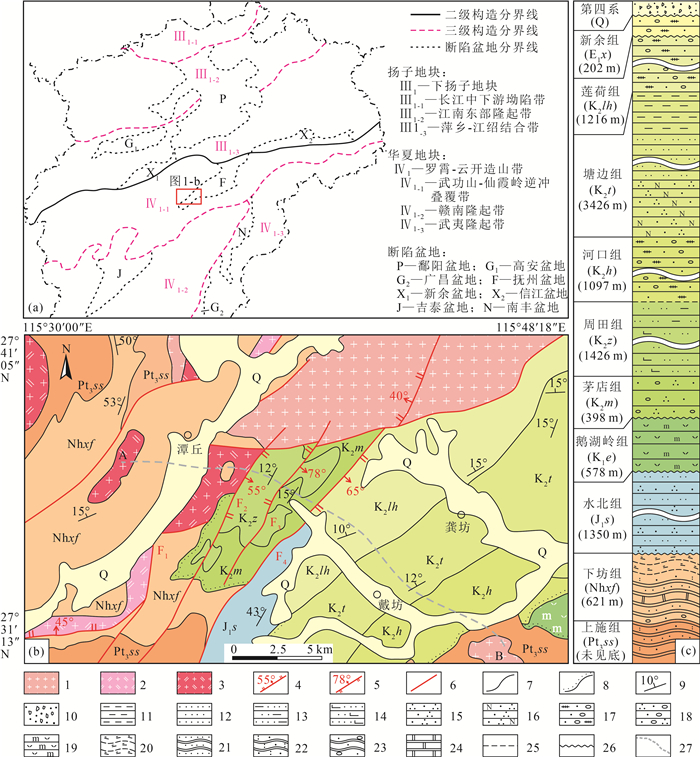
 下载:
下载:
